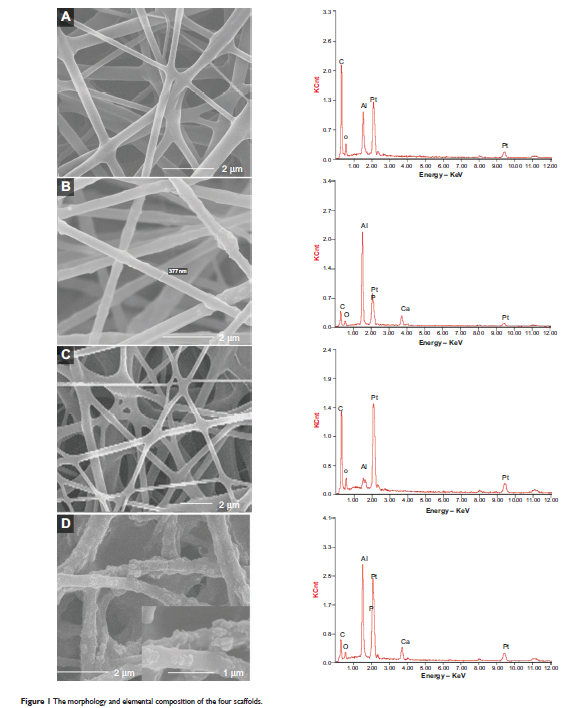9 1 2 3 6
论文已发表
注册即可获取德孚的最新动态
IF 收录期刊
- 2.6 Breast Cancer (Dove Med Press)
- 3.9 Clin Epidemiol
- 3.3 Cancer Manag Res
- 3.9 Infect Drug Resist
- 3.6 Clin Interv Aging
- 4.8 Drug Des Dev Ther
- 2.8 Int J Chronic Obstr
- 8.0 Int J Nanomed
- 2.3 Int J Women's Health
- 3.2 Neuropsych Dis Treat
- 4.0 OncoTargets Ther
- 2.2 Patient Prefer Adher
- 2.8 Ther Clin Risk Manag
- 2.7 J Pain Res
- 3.3 Diabet Metab Synd Ob
- 4.3 Psychol Res Behav Ma
- 3.4 Nat Sci Sleep
- 1.9 Pharmgenomics Pers Med
- 3.5 Risk Manag Healthc Policy
- 4.5 J Inflamm Res
- 2.3 Int J Gen Med
- 4.1 J Hepatocell Carcinoma
- 3.2 J Asthma Allergy
- 2.3 Clin Cosmet Investig Dermatol
- 3.3 J Multidiscip Healthc

已发表论文
静电纺丝制备纤维支架结合纳米羟基磷灰石诱导人类牙周膜细胞的成骨分化
Authors Wu XN, Miao LY, Yao YF, Wu WL, Liu Y, Chen XF, Sun WB
Published Date August 2014 Volume 2014:9(1) Pages 4135—4143
DOI http://dx.doi.org/10.2147/IJN.S65272
Received 1 April 2014, Accepted 3 June 2014, Published 27 August 2014
Abstract: Periodontal repair is a complex process in which regeneration of alveolar bone is a vital component. The aim of this study was to develop a biodegradable scaffold with good biocompatibility and osteoinductive ability. Two types of composite fibrous scaffolds were produced by electrospinning, ie, type I collagen/poly(є-caprolactone) (COL/PCL) and type I collagen/poly(є-caprolactone)/nanoscale hydroxyapatite (COL/PCL/nHA) with an average fiber diameter of about 377 nm. After a simulated body fluid (SBF) immersion test, the COL/PCL/nHA-SBF scaffold developed a rough surface because of the calcium phosphate deposited on the fibers, suggesting that the presence of nHA promoted the mineralization potential of the scaffold. Energy dispersive X-ray spectroscopy clearly showed the calcium and phosphorus content in the COL/PCL/nHA and COL/PCL/nHA-SBF scaffolds, confirming the findings of nHA and calcium phosphate precipitation on scanning electron micrographs. Water contact analysis revealed that nHA could improve the hydrophilic nature of the COL/PCL/nHA-SBF scaffold. The morphology of periodontal ligament cells cultured on COL/PCL-SBF and COL/PCL/nHA-SBF was evaluated by scanning electron microscopy. The results showed that cells adhered to either type of scaffold and were slightly spindle-shaped in the beginning, then extended gradually with stretched filopodia, indicating an ability to fill the fiber pores. A Cell Counting Kit-8 assay showed that both scaffolds supported cell proliferation. However, real-time quantitative polymerase chain reaction analysis showed that expression of the bone-related markers, alkaline phosphatase and osteocalcin, was upregulated only on the COL/PCL/nHA-SBF scaffold, indicating that this scaffold had the ability to induce osteogenic differentiation of periodontal ligament cells. In this study, COL/PCL/nHA-SBF produced by electrospinning followed by biomimetic mineralization had combined electrospun fibers with nHA in it. This scaffold has good biocompatibility and osteoinductive ability as a result of the characteristics of nHA, so could be innovatively applied to periodontal tissue engineering as a potential scaffold.
Keywords: nanoscale hydroxyapatite, electrospinning, periodontal ligament cells
Keywords: nanoscale hydroxyapatite, electrospinning, periodontal ligament cells
